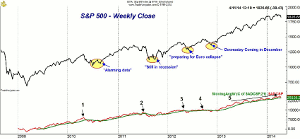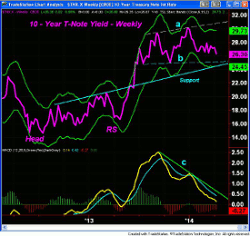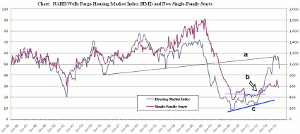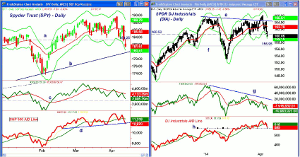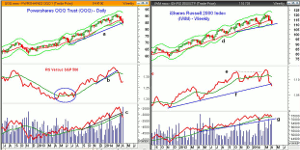The end of another rough trading week harkens back to the panic sell-offs that occurred in recent years and MoneyShow's Tom Aspray uses chart analysis to determine whether this sell-off will be followed by new bull market highs.
It was another rough week for the markets as the heavy selling came as the average investor was trying to digest the significance of the market rigging headline that I discussed last time. The selling hit panic levels on Thursday, but it is too early yet to conclude that the decline is already close to being over.
The technical picture last Wednesday allowed for two scenarios and, as of Friday, there is not enough evidence to be confident whether the large-cap Spyder Trust (SPY) and SPDR Dow Industrials (DIA) are going to join the Powershares QQQ Trust (QQQ) on the downside.
The plunge in the technology and biotechnology stocks is being tied to the perception that the economy is not strong enough to support the current high stock prices. This view is not really supported by the current numbers, as past market declines in this bull market have come in conjunction with much softer numbers than we are seeing now.
The current environment does remind me of the panic sell-offs that occurred in 2010, 2011, and 2012. I have circled these periods on the weekly close only chart of the S&P. For example, on August 27, 2010, there was this Bloomberg headline "El-Erian Says `Alarming' Data Show U.S. Economy Slowing."
The S&P 500 had actually made its low in early July 2010, but had a secondary low at 1039, the day this article was published. Below the chart of the S&P 5000 is a chart of the S&P 500 Advance/Decline line which reveals that it had made a new high the prior April (point 1) . By February of 2011, the S&P 500 had risen to 1344.
In the summer of 2011, there was the massive decline that began in late July that was followed by heavy selling in early August in reaction to the budget impasse and downgrade of US debt. By September, the fear of a double dip recession was being widely discussed. On September 7, a CNBC headline read "US Economy Is Basically 'Still In Recession': Fed's Evans."
The S&P 500 dropped to a low of 1074 on October 4, before reversing to the upside. The A/D line had made a new high in early July (point 2). A week after the low, there was strong technical evidence that the lows were in place, leading to my article "Be Bold, Be Fearless.Buy the Dip." By April 2012, the S&P 500 was trading well above 1400.
The A/D line made a new high that April, but by the end of the month, it had moved into the corrective mode. By May, the concern was over the troubles in the Eurozone with this headline on May 27 from the telegraph "Lloyd's of London preparing for euro collapse."
The S&P 500, which had traded as high as 1422 at the start of April, dropped to a low of 1266 on June 4, just five days after the article was published. The Euro dropped to a low of 1.2042 the next month and has been moving higher ever since. At the June lows, there were also strong technical signs that the correction was over, as I noted on June 6.
In the middle of September 2012, the A/D line made another new high (point 4), which is hard to tell from the chart. By the end of October, concerns over the economy and the outcome of the presidential election resulted in significant selling.
The S&P 500 had reached a high of 1474 in September and, by the time this headline appeared on November 7, it was down to 1394. The S&P bottomed on November 16 at 1343 and then rallied to close the year at 1426, despite a year end decline in reaction to the "fiscal cliff."
As the S&P 500 chart indicates, the A/D line has made a series of higher highs in 2013 and early 2014 (line 5) as its most recent high was on April 4. It does not yet show a new downtrend, which would be consistent with a deeper correction in the S&P 500 and NYSE Composite.
The bond market does seem to be a bit more worried as the yield on the 10 - Year T-Note looks ready to close at 2.63% as it has dropped below the lows of the past six weeks. The next strong support is in the 2.44-2.50% area and the weekly starc- band. The MACD shows no sign yet of bottoming as it is still in a downtrend, line c.
NEXT PAGE: What to Watch
|pagebreak|
The economic calendar was quite light last week, though the mid-month reading from the University of Michigan on consumer sentiment beat estimates on Friday as it came in at 82.6. This is the highest reading since last July. It is consistent with my view that the consumer will return with a vengeance as the weather warms up.
This week we get Retail Sales and the same store sales data was better than expected last week. Also, on Monday, we get Business Inventories. The Consumer Price Index is out on Tuesday, along with the Empire Manufacturing Survey and the Housing Market Index (HMI).
Long time readers will recall that it was the HMI that helped confirm the low in the housing market. In 2012, the HMI completed its bottom formation, line c, when it started a new uptrend at point b. On a technical basis, the HMI reached resistance at line a, but shows no signs yet that the uptrend is over.
Housing Starts will be released on Wednesday, and also Industrial Production. Thursday we get the weekly jobless claims and the Philadelphia Fed Survey. The markets are closed on Friday for Good Friday but the Leading Indicators will be released.
What to Watch
The sellers took over last week as Thursday's drop erased Wednesday's gains and more selling hit the market on Friday. The PowerShares QQQ Trust (QQQ) and iShares Russell 2000 Index (IWM) have broken through more important levels of support but the other major averages have not.
The extent of the decline has many wondering if, or when, the NYSE Composite, Spyder Trust (SPY) and SPDR Dow Industrials (DIA) will follow. The NYSE is the broadest measure, and therefore, the most important.
The five-day MA of the percentage of Nasdaq 100 stocks above their 50-day MAs has dropped down to 37.96%, which is the lowest level since November of 2012. The three year chart shows that it did hit 15% in June of 2012 and was below 10% in the fall of 2011.
For the S&P 500, the 5-day MA is at 62%, which is the mean. In early February, it had a low just above 30%, so this does have further room to fall.
According to AAII, the individual investors have become more bearish, dropping to 28.4%, down from 35.4% the prior week. It hit a high of 55% at the end of 2013. The number of bears has also increased to 34%.
The NYSE Composite looks ready to close the week just above the quarterly pivot at 10,270. If this level is decisively broken, there is next good support in the 9,900-10,000 area. In early February, the low was 9,732.
The McClellan oscillator closed below support, at line c, on Thursday, suggesting that it will move to truly oversold levels below -300 that were last seen in August of 2013. It looks as though the break of the downtrend, line b, at the end of March, was a fake out.
NEXT PAGE: Stocks
|pagebreak|
The daily NYSE Advance/Decline is getting closer to its trend line support at line d. A close below the low made on March 27 would be more negative. The market internals were about 2-1 negative on Friday.
It is important to remember that both the weekly and daily NYSE A/D lines have made a new high recently. Therefore, though the market is acting vulnerable right now, the bull market is not over.
S&P 500
On the daily chart of the Spyder Trust (SPY), the sharp drop at the end of last week is quite clear as it closed well below the 20-day EMA at $185.63. The close was also below the quarterly pivot at $183.25, line a.
The daily starc- band is at $180.58 with the weekly at $177.56. The 38.2% Fibonacci retracement support from the June 2013 low is at $176.67, which is just below the quarterly projected pivot support at $176.97.
The daily OBV continues to show a pattern of lower highs and is getting close to stronger support at line c. The weekly OBV (not shown) is still above its WMA, but not by much, and could drop below it this week with another lower weekly close.
There is first resistance now at $183.60 with further in the $184.40-$185 area.
The daily S&P 500 A/D line now dropped below the most recent low and is testing the more important support at line d. A close below the late March low will confirm a new downtrend. Therefore, any rally will need to be watched closely.
Dow Industrials
The SPDR Dow Industrials (DIA) also looks ready to close below its quarterly pivot at $160.88.
The rising 20-day EMA at $163.40 should provide first support with further in the $162 area. There is more important support in the $160.52 area with the quarterly pivot at $160.88, as well as the support at $160.52.
There is next chart support now at $156.95 with the quarterly projected pivot support at $156.25. In February, DIA had a low of $152.44.
The daily on-balance volume (OBV) is still acting weak as it has made lower highs, line g, and looks ready to test the February lows.
The daily Dow Industrials A/D line, after confirming the upside breakout, has reversed sharply and is back below its WMA. There is next important support at the mid-March lows and the early January high, line h.
As I noted in Friday's column, the comparative analysis of the DIA versus the QQQ suggests it is becoming a leader after lagging for some time. I had noted previously that it was also starting to outperform the SPY.
Nasdaq-100
The volume in the PowerShares QQQ Trust (QQQ) was even heavier than the prior week, a sign of the relentless selling. The weekly low close doji sell signal from March 14 was really on target. The weekly uptrend, line a, is now being tested with the weekly starc- band at $83.03. The quarterly projected pivot support is just a bit higher at $83.53.
The relative performance has been negative for several weeks as it broke support, line b, and its WMA. The RS line is now back to the late 2013 lows.
The weekly OBV will close the week below its uptrend, line c, and its still rising WMA. The daily OBV (not shown) is acting weaker than prices as it has dropped below the early October lows.
The Nasdaq 100 A/D has dropped below the lows of the past two months but is actually acting stronger than prices. Its WMA is now declining.
There is initial resistance now at $85-$86 with the 20-day EMA at $87.45.
Russell 2000
The iShares Russell 2000 Index (IWM) came close to its declining 20-day EMA last week before dropping to significant new lows. The weekly uptrend, line d, is now being tested with the weekly starc- band a bit lower at $108.03. The February low was $106.99.
The weekly relative performance will break its long-term uptrend, line f, this week. The upside breakout in March was a false one. The daily RS line still looks very weak as it is well below its WMA.
The weekly OBV looks ready to close just below its WMA, so the multiple time frame OBV analysis is still negative. The OBV has further support at the uptrend, line g.
The Russell 2000 A/D Line (not shown) is now in a clear downtrend.
There is minor resistance now for IWM at $112.50-$113 with stronger at last week's high of $115.25.
NEXT PAGE: Sector Focus, Commodities, and Tom's Outlook
|pagebreak|
Sector Focus
The iShares Dow Jones Transportation (IYT) closed on the week's low and below the quarterly pivot at $132.63. There is more important support now in the $130-$131 area. There is additional support at $128 with the February lows at $125.17.
The weekly relative performance and OBV (not shown) are likely to close the week below their WMA and the daily studies are negative.
The SPDR Dow Industrials (DIA) , iShares Russell 2000 Index (IWM), PowerShares QQQ Trust (QQQ), and Spyder Trust (SPY) are all negative with IWM down 4.6%.
The Select SPDR Utilities (XLU) is leading by even more now as it is up 9.6%, while the Select SPDR Health Care (XLV) is only up slightly for the year.
The Select SPDR Energy (XLE) and the Select SPDR Materials (XLB) have also reversed and most of the sector ETFs are now negative for the year.
The Select SPDR Consumer Discretionary (XLY) is now down almost 7%, while the Select SPDR Consumer Staples (XLP) is down just 0.6%.
The Select SPDR Financials (XLF) was up 2.6% just a month ago, but is now down 2.4% for the year.
Crude Oil
Crude oil was a bit lower last week as it has corrected for the past two weeks. The OBV has turned lower but is still above its WMA. The volume on the downside last Thursday was heavy so the strength of the next rally will be important.
Precious Metals
The SPDR Gold Trust (GLD) closed the week positive as it surpassed its quarterly pivot two weeks ago. The daily OBV is still below its WMA, suggesting that one more pullback is needed before a bottom is completed. The 50% Fibonacci support has been slightly violated with the 61.8% at $121.80.
The Week Ahead
The decline last week does increase the odds that we will see a deeper correction in the NYSE Composite, S&P 500, and Dow Industrials. If the S&P 500 has a decisive close below 1795 then it could drop all the way back to the 1750-1770 area.
Still, there are no signs that the bull market is over and I expect to see the economic data get even better over the next month or so and that should support prices.
The mid-week rally allowed for a test of the highs over the near term but does not look likely now. The key A/D lines have not yet broken the late March lows, and if they do, it will signal a deeper correction.
On a short-term basis, the market is getting oversold, so we should see a bounce this week. Unless it is quite strong, it will likely be an opportunity to become more defensive and raise some cash.
Despite the sharp decline, there are still quite a few stocks, especially some of the large-cap household names whose charts and volume patterns still look positive. I do expect these stocks to lead once the market's decline is over.
For the next few days, I would stick with your plan and the previously determined stops. On a weak rally, though, I will be Tweeting some sell recommendations in the Charts In Play Portfolio.
I have been recommending, for the past month, that you take some profits when you have them and hope that such action was taken.
Stick with the dollar cost averaging positions in either the S&P 500-tracking ETF or Vanguard Emerging Markets (VWO) that I discussed in the January 24 column, A Path to Investing Success in 2014. The VWO held up very well last week and will be a buy once we get a pullback, as the technical studies are positive.
Those who were not in the market should have started a dollar cost averaging plan on Friday, as the S&P 500 closed below 1830 on Thursday. Make four more equal purchases every two weeks until you are fully invested.
Don't forget to read Tom's latest Trading Lesson, Follow the Trend with Quarterly Pivots.

